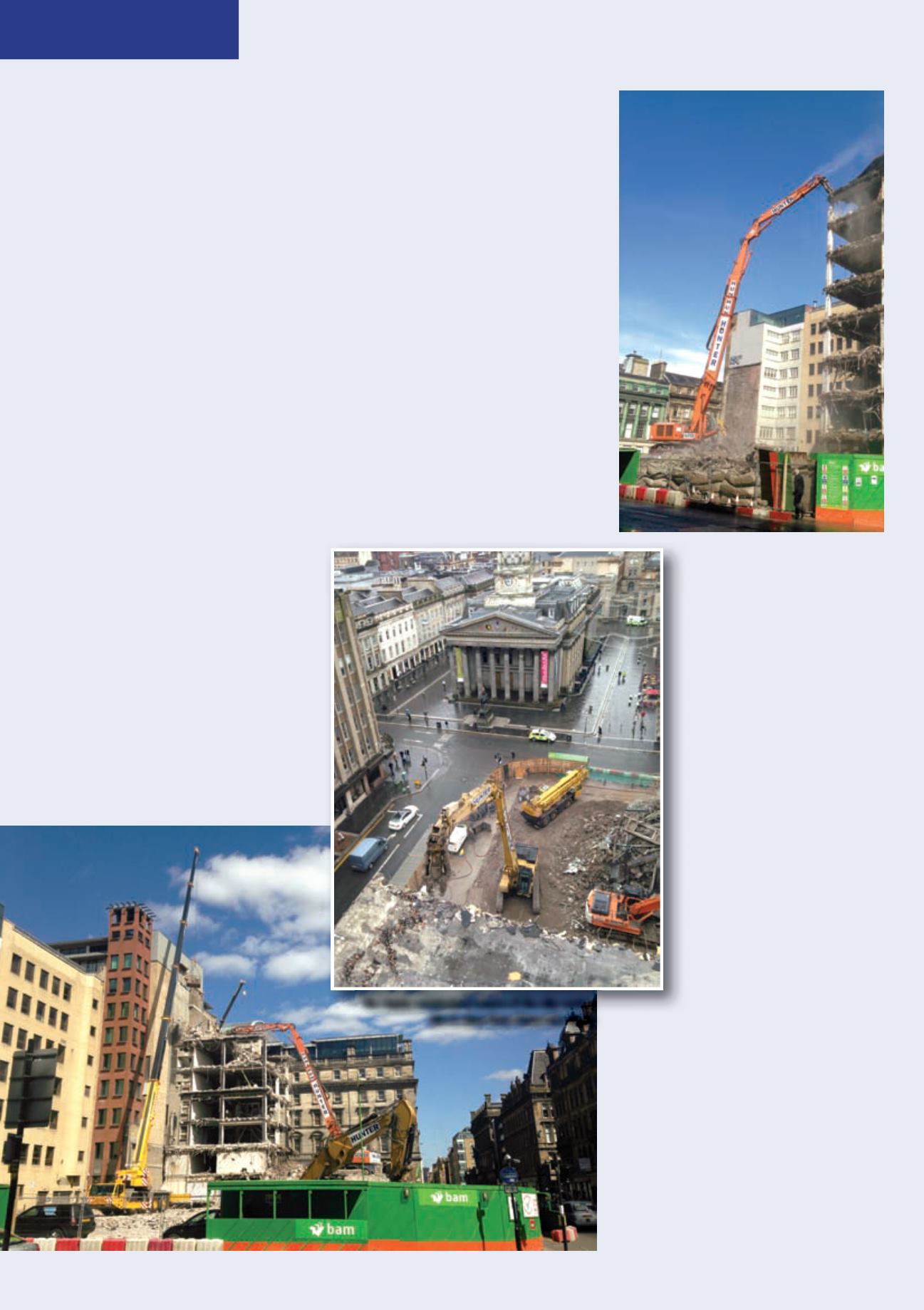
16
NOVEMBER-DECEMBER 2013
d
&
ri
DEMOLITION AWARDS
level the material from the demolition was then
processed on site and set aside for crushing
to 6f2 grade at a later date. In total, Hunter
removed 2,822.5 tonnes of 6f2, 1.9 tonnes of
timber, 5,338.8 tonnes of concrete and 929.3
tonnes of miscellaneous scrap, all of which will
be processed for recycling.
The two ends that tied into the
neighbouring properties were then demolished
using a mixture of mechanical and hand
demolition since a 250 mm (10 inch) cavity
had been found between the buildings during
original investigation works.
Due to the location and the close proximity
of pedestrians and vehicles, Hunter carried
out some of the demolition works during the
evenings and on Sundays. This part of the work
involved localised footpath and road closures
and was carried out working very closely with
the local council’s roads department, local
bus companies, surrounding businesses and
residents to allow the corner sections that were
located close to the normally 'live' footpaths
and roads to be taken down.
Asbestos removal and internal soft stripping
works had been undertaken by others prior to
the demolition work commencing. However,
once work was underway and Hunter was
three weeks into the programme, asbestos
was discovered. Work within this area ceased
immediately until testing was carried out.
While this was ongoing, and rather than
work stop completely, the methodology was
changed in agreement with the client and the
team moved to another area to commence
demolition, therefore allowing the contractor
to stay within programme.
With the above ground demolition
complete Hunter started to remove the material
from within the basement and break out the
basement walls and the walls to the vaults.
Crushing of demolition rubble started and
while this was ongoing removal of the pile caps
commenced. With all the basement removal
The monitoring levels were always
below the appropriate British
standard and as a goodwill gesture
to these businesses and residents,
Hunter introduced a quiet hour
each day to allow them to conduct
sensitive business - this proved to
be a success.
The site was also under the
Considerate Contractors Scheme
and was visited by an auditor to
conduct an assessment. The site
scored 42 out of 50 (the first for a
BAM site) and special recognition
was given to the dust suppression
system that was in force.
Gordon Topham, Consider
Contractors Scheme Auditor said
that “the introduction of a Snow
Making machine adapted to project
an atomised water mist over the
full demolition area trapped any
dust created by the works and
brought it effectively to the ground.
The air quality on site and in
adjacent streets is independently
monitored and compared to the
pre-start results. These checks
demonstrated that the air quality has not
decreased and that the local passers-by and
buildings are not being detrimentally affected
by the unavoidable dust created by work of
this nature. If this system was adopted on all
demolition sites a considerable improvement
would be seen across the industry in the air
quality on demolition sites.”
Hunter removed the original street signs
and a brass plaque that commemorated a
previous school and Gaelic Church that had
been on the site from 1818 until 1839, when
it was demolished to make way for the British
Linen Bank. These artefacts are likely to be
donated to a local museum.
■
The highly constrained nature of the city centre
site is clear from these two shots
Dust suppression on the site
was crucial – here both a
cannon and the machine itself
are ensuring the minimum
of dust is generated by the
demolition work
works complete Hunter Demolition backfilled
and compacted 6f2 material in 300 mm (12
inch) layers up to the existing ground level
ready for piling works to commence by the
client.
CUSTOMER CARE
Customer care was a large factor in this project.
Complaints of varying natures arrived daily.
The chair of the Local Community Group, who
was acting as spokesperson for the Community,
delivered a few complaints that were handled
immediately. He also delivered a number of
compliments regarding “the site management
being spot on” and the appearance of the
site. The site was also visited by Glasgow
City Council's Environmental Health on
a few occasions who were following up on
complaints received directly by them.
In order to ensure that there was no danger
or impact to surrounding buildings due to the
work involved in the demolition, movement
and vibration monitoring was established in
a number of buildings around the site. This
helped to alleviate concerns from various
businesses and residents related to possible
impact on the stability of their own buildings.


